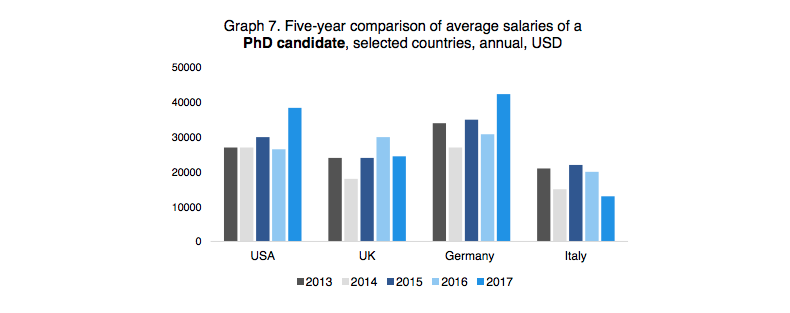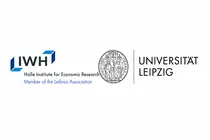The following article is archived and is no longer considered up-to-date. Please interpret its content in the context of the publishing date.

ARCHIVED
Salary Gap Between Positions in Academia Slowly Narrowing
Read a summary using the INOMICS AI tool
The following is an analysis of data taken from the INOMICS Salary Report 2018 - downloadable for registered users here. Specifically, it looks at the average salaries of PhDs, Post-Docs, and Full Professors, working in economics over the last 5 years, in the U.S, the U.K, Germany, and Italy. It is the 4th instalment in a series of insights handling the Report’s findings.
With the Salary Report now in its 5th year, sufficient data has been collected from the U.S, the U.K, Germany, and Italy, to compare the wages of PhDs, Post-Docs, and Full Professors over the last half a decade, beginning in 2013.

As Graph 7 shows, the salaries of PhD candidates in the respective 4 countries have fluctuated somewhat over the last five years. In the USA and Germany, there can be observed a slight increase over the period, perhaps reflecting their improving economies. 2017, in particular, proved for both countries a lucrative year for economists of this status. In comparison with Italy, the inverse can be observed, and a slight decline in salary is visible. Of the four, the UK stands out as the anomaly, experiencing relatively consistent wages at this level.

This consistency of wages in the UK is also apparent for those engaged in Post-Docs. Although offering the highest average salary over the last 5 years, the U.S, similar to Germany, showed largely stagnant salaries, both seeing a marginal decline over the previous 3 years. Italy, while showing signs of a modest increase in the last 2 years remains the lowest of the Western countries included. The general trend of a Post-Docs’ average salaries going down mirrors that of PhD holders who also earned less in 2017 than they did previously.

From Graph 9, it can be observed that in all four countries that were analysed, the average salary of full professors grew between 2013 and 2016, although a modest drop seems to have taken place thereafter. This may be partially explained by the significant shifts in currency exchange rates between 2014 and 2016. Interestingly, we can analyse how the salaries of professionals from the same country, but in different positions have changed over time. For instance, in Germany in 2013 there was a huge gap between the average salary of a PhD candidate and a full professor, and even until as recently as 2015 full professors were earning more than three times as much as PhD candidates. During the last two years, however, this gap has shrunk, with PhD candidates’ salaries going up in 2017 and full professors’ salaries dropping slightly. Although the difference is still significant (more than double), there is a clear trend towards narrowing salaries between positions in academia.
There will be more analysis of the Salary Report’s findings in the upcoming weeks, keep an eye on the INOMICS insights section for future instalments. Additionally, for career opportunities and job listings in business, finance, and economics, take a look at our jobs section. It has all that you will need to take that next big step!
-
- Assistant Professor / Lecturer Job
- Posted 2 weeks ago
Assistant Professor-Economics
At University of Wisconsin Stevens Point in Stevens Point, USA
-
- Postdoc Job
- (Hybrid)
- Posted 5 days ago
Postdoctoral Research Fellow (with both Quantitative and Qualitative Skills)
At Economic and Social Research Institute (ESRI) in Dublin, Irland
-
- PhD Candidate Job
- Posted 3 days ago
Fully Funded PhD Positions in Economics, University of Lugano (USI), Switzerland
At Università della Svizzera italiana (University of Lugano) in Lugano, Schweiz












